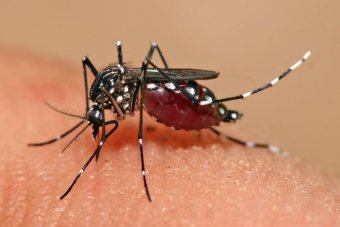seA drug to treat one of the world’s most debilitating mosquito-borne viruses is within grasp, Australian researchers say.
The breakthrough in the fight against dengue fever is the result of more than 30 years’ work by University of Queensland (UQ) researcher Professor Paul Young and colleagues on the protein NS1, which is associated with the dengue virus.
Professor Young and his team, from UQ’s School of Chemistry and Molecular Biosciences and the Australian Infectious Disease Research Centre, have revealed that drugs developed to treat sepsis, an infection of the blood, have been used to successfully treat dengue fever in mice.
Professor Young said this meant his team could “jump-start human clinical trials” within the next two years, as the safety trials normally required to move to this stage have already been done.
Dengue typically causes a debilitating fever but can progress to potentially fatal dengue hemorrhagic fever and dengue shock syndrome.
Dengue facts
- Dengue typically causes a debilitating fever, headaches, rash and joint and muscle pain
- Some people who are infected will not have any symptoms, but others can develop a potentially fatal complication known as dengue haemorrhagic fever
- The dengue virus is transmitted to people via mosquitoes
- There are four strains of virus.
- After being infected with one type of dengue you are immune to that specific type for life, but not the other strains.
- The risk of haemorrhagic fever increases if you catch dengue more than once.
- The virus is estimated to infect up to 400 million people globally each year
- In Australia, the dengue mosquito had been reported as far south as Rockhampton on the Tropic of Capricorn in Queensland.
But Professor Young said early detection of the virus — now common thanks to a test he developed about 10 years ago — and treatment with drugs would stop the virus progressing to the more severe form of the disease.
In the paper published today in Science Translational Medicine, Professor Young and his team show the excessive response of immune cells to the dengue virus NS1 protein are responsible for the leakage of fluid from blood vessels that causes haemorrhage in severe dengue disease.
In particular the researchers found NS1 activated a receptor protein, known as Toll-like receptor 4 (TLR4), to excessively release inflammatory proteins that led to leakage from blood vessel walls.
They also found the NS1 protein itself acted directly on the endothelial cells that line blood vessel walls.
Professor Young said the key to their drug breakthrough was the involvement of TLR4.
“TLR4 is the major pathway through which bacteria stimulate a similar response [in the body] that leads to the disease of sepsis, which is a scourge in hospital environments,” he said.
“As a consequence the past 20 years has seen pharmaceutical companies and other researchers chasing drugs that can block that activity.
“So we just re-purposed some of those existing drugs that have already gone through clinical trials and sure enough they blocked the NS1 activity in cell cultures and our animal models.”
Window of opportunity
He said the drugs they were targeting had failed as a treatment for sepsis, but he believed they would be successful in treating dengue.
“With sepsis you are dealing with patients that are very far down the line. It’s like there is a thunderstorm and you take a bucket out to collect all the water. It’s not enough and it’s too late in the infection,” he said.
“But with dengue we think we’ve got that window of opportunity because we’ve got a diagnostic assay that can pick up infected individuals two to three days before they progress to those [more severe] symptoms — so we can prevent it before it starts.”
Professor Young said the dengue virus would be a growing problem as increased temperatures and rainfall associated with global warming increased the range of the dengue-carrying mosquito.
Their work may also have a flow-on impact in the treatment of other tropical diseases.
Professor Young said the protein is found in viruses in the same family as dengue and the team had already found the NS1 protein played a similar activation role with immune cells in West Nile encephalitis and yellow fever.
“We are now chasing to see if it plays a role in the pathology of those diseases,” he said.
He also believes the NS1 protein could be critical in any development of a vaccine.
In an accompanying paper in Science Translational Medicine, Berkley University researchers show NS1 used as a vaccine will protect mice from the viral challenge.
“This is a missing piece in the puzzle of the pathogenesis of dengue,” said Professor Eva Harris, senior author of the study.
“The role of NS1 itself had been overlooked in severe forms of dengue disease, but we now know that it is an important player. Our findings show that NS1 could be a prime target for drugs, and that it should be considered in vaccine development.”

